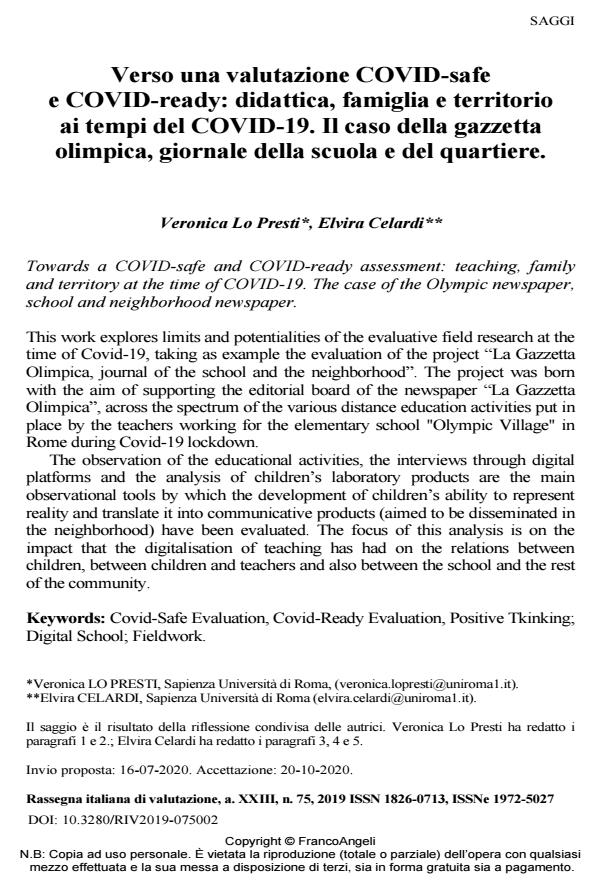Towards a COVID-safe and COVID-ready assessment: teaching, family and territory at the time of COVID-19. The case of the Olympic newspaper, school and neighborhood newspaper
Journal title RIV Rassegna Italiana di Valutazione
Author/s Veronica Lo Presti, Elvira Celardi
Publishing Year 2021 Issue 2019/75 Language Italian
Pages 16 P. 7-22 File size 258 KB
DOI 10.3280/RIV2019-075002
DOI is like a bar code for intellectual property: to have more infomation
click here
Below, you can see the article first page
If you want to buy this article in PDF format, you can do it, following the instructions to buy download credits

FrancoAngeli is member of Publishers International Linking Association, Inc (PILA), a not-for-profit association which run the CrossRef service enabling links to and from online scholarly content.
This work explores limits and potentialities of the evaluative field research at the time of Covid-19, taking as example the evaluation of the project "La Gazzetta Olimpica, journal of the school and the neighborhood". The project was born with the aim of supporting the editorial board of the newspaper "La Gazzetta Olimpica", across the spectrum of the various distance education activities put in place by the teachers working for the elementary school "Olympic Village" in Rome during Covid-19 lockdown. The observation of the educational activities, the interviews through digital platforms and the analysis of children’s laboratory products are the main observational tools by which the development of children’s ability to represent reality and translate it into communicative products (aimed to be disseminated in the neighborhood) have been evaluated. The focus of this analysis is on the impact that the digitalisation of teaching has had on the relations between children, between children and teachers and also between the school and the rest of the community.
Keywords: Covid-Safe Evaluation, Covid-Ready Evaluation, Positive Tkinking; Digital School; Fieldwork.
- Rivoltella P., Rossi P., a cura di (2019) Tecnologie per l’educazione. Milano: Pearson. Selwyn N. (2012). Bursting out of the «Ed- Tech» bubble. Learning Media and Tecnology, 37:331-334.
- Scriven M. (1980). Evaluation Thesaurus. Second Edition. Edgepress Inverness California
- Stame N., Lo Presti V., Ferrazza D. (2010). Segretariato sociale e riforma dei servizi. Percorsi di valutazione. Milano: Angeli.
- Stame N. (2016). Valutazione pluralista. Milano: Angeli.
- R. Stake, 1995, The Art of Case Study Research. Sage: Thousand Oaks.
- Stake, R.E. (2005). Qualitative Case Studies. In: Denzin, N.K., Lincoln, Y.S., Eds., The Sage Handbook of Qualitative Research, 3rd Edition.
- Stake, R.E. (2005) Qualitative Case Studies. In: Denzin, N.K. and Lincoln, Y.S., Eds., a cura di, The Sage Handbook of Qualitative Research, 3rd Edition. London: Sage Publications.
- Stern E. (2015), La valutazione d’impatto. Una guida per committenti e manager preparata per Bond. FrancoAngeli.
- Tendler J. (1993). Progetti ed effetti. Napoli: Liguori.
- Pawson R., Tilley P.N. (1997). Realistic Evaluation, UK: Sage Publications Ltd.
- Revoltella P. C. (2014). Smart Future. Didattica, media e inclusion. Milano: Angeli.
- Aureli T. (2002). L’osservazione del comportamento del bambino. Bologna: Il Mulino.
- Billson J.M. (1986). The college classroom as a small group: Some implication for teaching and learning. Teaching Sociology, 14: 143-151.
- Calvani A. (2001) Manuale di tecnologie dell’educazione, nuova ed. ampliata e aggiornata. Pisa: ETS.
- Celardi E. (2019). L’implementazione della Carta Acquisti Sperimentale a Catania. Quali effetti? In: Brancato G., D’Ambrosio G., De Marchis E. E., Ficcadenti C., Gallo R.; Grivet Talocia F., Stolfi M., Tedesco M, Vaccaro A., a cura di, CNDSS 2018 Atti della III Conferenza Nazionale delle Dottorande e dei Dottorandi in Scienze Sociali. Roma: Sapienza, Università Editrice, 49:380-388.
- Ciliberti A. (1995). Manuale di glottodidattica.Firenze: La Nuova Italia.
- Corsaro W. (1985). Friendship and peer culture in the early years. Hillisdale, NJ: Ablex.
- Giancola O., Grimaldi E., Romito M., (2019). La digitalizzazione della scuola. Temi, teorie e metodi di ricerca. Scuola Democratica, 10: 461-479.
- Falcinelli F., a cura di (2005). E-learning. Aspetti pedagogici e didattici. Perugia: Morlacchi.
- Guba E., Lincoln Y. (1981). Effective Evaluation. San Francisco: Jossey Bass.
- Guba E., Lincoln Y. (1987). The Countenances of Fourth Generation Evaluation: Description, Judgement and Negotiation. In D. J. Palumbo, a cura di, The politics of Program Evaluation. Beverly Hills: Sage.
- Gui M. (2019). Il digitale a scuola. Rivoluzione o obbligo. Il Mulino: Bologna.
- Hirschman A. O. (1967). Development Projects Observed. Washington, DC: The Brookings Institution.
- Lo Presti V. (2017). Positive thinking e sviluppo locale: quali approcci per la promozione dell’innovazione nelle aree interne. Sociologia e Ricerca Sociale, 2:138-155.
- Lo Presti V. (2020). L’uso dei Positive Thinking nella ricercar valutativa, Milano: Angeli.
- Lo Presti V., Dentale M., Celardi E. (2018). Ricerca valutativa e Case Study Research: un caso "positivo" di valutazione dell’infrastrutturazione sociale a Palermo. Rassegna Italiana di Valutazione, 71-72: 9-30.
- Meldolesi L. (1994). Alla scoperta del possibile, il mondo sorprendente di Albert Hirschman. Bologna: il Mulino.
- Ofir Z. (2020). Transforming Evaluations, Part 5. COVID-Safe, COVID-Ready and COVIDInformed, Evaluation. -- Testo disponibile al sito: https://zendaofir.com/transformingevaluations-and-Covid-19-part-5/, 20-05-2020.
- Paoletti I., Fele G. (2004). Order and disorder in the classroom. Pragmatics. Quartely Publication of the international Pragmatics Association (IPrA), 14: 69-85.
Veronica Lo Presti, Elvira Celardi, Verso una valutazione COVID-safe e COVID-ready: didattica, famiglia e territorio ai tempi del COVID-19. Il caso della gazzetta olimpica, giornale della scuola e del quartiere. in "RIV Rassegna Italiana di Valutazione" 75/2019, pp 7-22, DOI: 10.3280/RIV2019-075002